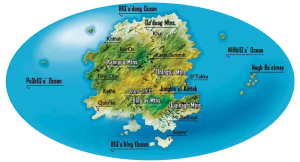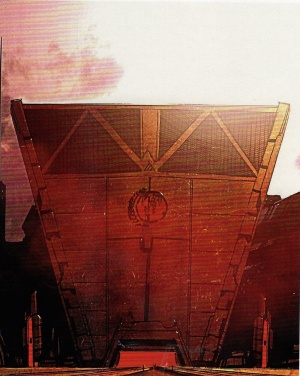Qo'noS
From Star Trek: Theurgy Wiki
The star named K'lai Klinzhai, also called K'thar, was located in the Qo'noS sector of the Beta Quadrant. Qo'noS was the homeworld of the Klingons and the capital world of the Klingon Empire. The First City of Qo'noS housed the Klingon High Council and other important institutions, like the Klingon Defense Force Command Headquarters. The namesake of Qo'noS were poH qut, time crystals, a mineral which was also a symbol of Kahless. Early Federation records named the Klingon homeworld "Epsilon Sagittarii B", but it is a name that has become considered moot. Qo'noS had one damaged moon, named Praxis.
Described as a "planet of caves", Qo'noS was composed of a subterranean series of volcanoes, which lay dormant for centuries, to the point of being considered extinct, before becoming alive again in the 2250s. Some caves were of substantial size, including caves not connected to the volcano system. The planet had chaotic weather systems; thunderstorms were frequent.
History & Features
The Klingon Empire was first formed around the end of the first millennium, this Empire fell to the Hur'q, as did the ancient Karsid Empire. The Klingons soon recovered and began to build their Empire. By the 22nd century the Klingons were a major power in the Beta Quadrant.
Throughout much of the 23rd century the Klingons were engaged with hostilities with the United Federation of Planets which finally came to an end in 2293, when the ozone layer on Qo'noS was severely damaged when Praxis - the moon and also a key energy-production facility for the Klingon Empire - exploded after an accident involving over-mining. Its destruction sent out a subspace shock wave, and this event forced planning for the evacuation of Qo'noS and led to the signing of the First Khitomer Accord with the Federation.
The First City
Out of the other five planets in the system, Qo'noS was the only habitable Class M planet, though it required a certain level of technology in order to maintain the environment. The First City (Klingonese: veng wa'DIch) was a municipality on Qo'noS near the Qam-Chee River, and the capital city of the Klingon Empire. It was located in the southern hemisphere of the planet Qo'noS. The seat of the Klingon High Council, it was home to the Klingon High Council Chamber as well as the Great Hall. Beneath the High Council chamber was one of the seven chimneys leading to the planet's underground volcano system. Previously, the site had housed an ancient shrine to Molor.
The First City has outworlders living in the city, both within and without the city's boundaries. In the city are a large population of non-Klingon permanent residents, both the descendants of subjugated species and beings from allied worlds. There is also a large community of merchants from various worlds and races, especially Tellarites. Due to ongoing disputes with Cardassia, there aren't many Cardassians in the First City, and it's rare to find any Romulans if at all. Foreigners aren't allowed to build homes or businesses in the architectural style of their home worlds, thereby preserving the city's historical and traditional aesthetic.
The First City was thrown into chaos in 2375 when Gothmara and Morjod initiated a coup against Martok. The Great Hall was damaged by Morjod's Hammer and the Klingon High Council were killed. By 2379, however, the Great Hall was rebuilt, and new Councillors had taken the seats of the fallen.
Other Features
The planet itself possessed a single landmass that comprised the entire habitable surface. The terrain consisted primarily of high, rocky mountains, jagged cliffs, and rivers of lava, which were the result of unstable tectonics. A greenhouse effect caused by the volcanic ash kept the planet's surface warm and trapped its oxygen-nitrogen atmosphere. The interaction of cold air over the ocean and extremely hot air over the continents gave rise to sizable storms; with no land on the planet's far side to halt their growth, hurricanes the size of Earth's North America formed over the sea and slammed into the land like a sledgehammer. Visitors to Qo'noS found it difficult to move around in the high gravity (1.23G) and thick atmosphere causing fatigue among those who visited the planet.
The Klingon homeworld is the most heavily defended planet in known space, due to the Klingons' natural distrust and paranoia being at its peak when it comes to the defense of their homeworld. It's planetary defenses include a huge network of defense satellites, both manned and unmanned. Orbital stations which are similar to those near most Klingon colony worlds but significantly larger, each of which is capable of fighting off a small fleet. These orbital stations are powered by antimatter generators, making them useful not only against spaceborne invaders but also against the capital's population (as a check against rebellion, as they face a network of the largest bombs known in orbit).
The Caves of Kahless were a subterranean complex of chambers located in the northern polar region of Qo'noS. Named after Kahless, traditional observances of the Day of Honor were held in these caves.
No'Mat, or the Caves of No'Mat, was a location in the southern hemisphere of the planet Qo'noS. This icy mountainous location was known for its lava caves. These caves played a role in the Rite of MajQa wherein a young Klingon while meditating would experience a vision. This vision, or hallucination depending upon one's interpretation, might play a role in the Klingon's future.
The Mekro'vak region was a provincial area on the Klingon homeworld of Qo'noS. It was located near the equator, north of the Hamar Mountains and southwest of Kang's Summit. It was home to the House of Grilka and many of their lands were held there. Among the people of the Mekro'vak, it was customary for a male to bring a fresh leg of lingta to the first courtship dinner with the lady he pursued. He would then make room for it by removing everything else from the table with one sweep of the lingta and announce loudly, "'I have brought you this. From this day, I wish to provide food for you and your House. All I ask is to share your company and do honor to your name."
The Ketha Province was a far southern region on the Klingon homeworld of Qo'noS. It included the Ketha lowlands, which were a generally impoverished region of Ketha Province. Chancellor Martok was born in the Ketha lowlands.
Locations in Detail
The Old Quarter
This is the oldest part of the First City, located in its north-eastern quadrant. The area grew from old settlements of disparate communities of settlers, evolving from simple military fortifications into a bustling city. Traversing the old streets and paths, bridges and tunnels that connect the area allow visitors to sample a variety of stores, galleries, museums and ancient landmarks.
The Open Air Bazar
In the Qav Quarter, of the First City's south-eastern region, this shopping area is one of the best places in the city to sample a broad cross section of clothing, décor, crafts, foods and spirits from around the Klingon home world. Restaurants and taverns are frequently encountered, and street merchants at every corner.
The Federation Embassy
The Federation Embassy on Qo'noS was the permanent diplomatic mission of the United Federation of Planets in the Klingon Empire. The Federation Embassy was a large - over two hundred meters tall - rust-colored structure located in the First City; shaped like an inverted pyramid with the corners supported by high columns, it was the formal workplace of the Federation Ambassador to the Klingon Empire, and was considered to be legally Federation soil.
The Embassy was surrounded by a ten meter high fence and force field designed to protect the structure from most conventional attacks. In order to gain entrance to the embassy, an eight digit code, retinal scan, and verbal authentication was required. It also maintained constant contact with Federation space through subspace radio, and had the capacity to launch a cloaked probe into orbit in times of emergency to send distress beacons. It was also equipped with standard anesthizine gas defenses such as those found on Federation starships. Nonetheless, the Federation Embassy on Qo'noS suffered a number of notable security lapses.
In 2376, the Embassy was seized and its personnel placed under the mental control of Morjod, son of Martok, as part of his unsuccessful coup attempt, and in 2379, a small band of radicals managed to temporarily storm the Embassy and take its staff hostage until Ambassador Worf personally fought them for control of the building. In the basement of the Federation Embassy, a classified operations center of Starfleet Intelligence was located.
The Embassy also had a museum dedicated to the long, often tumultuous relationship between the Klingon Empire and the Federation. The exhibit contained many artifacts, documents and presentations that showed the alliance's history. The exhibit also had a holographic recreation of the 2372 invasion by the Klingons when they withdrew from the Khitomer Accords.
Associate Consul Annup Bommu was a male human in the 24th century and the ranking Federation ambassador on Qo'noS when Morjod, son of Martok attacked in the year 2375. He was the grandson of Padwa and was of Indian origin. Ms. Barnum was a member of the Federation embassy staff on planet Qo'noS when it was attacked in the year 2375. She was Annup Bommu's assistant and also from India, on Earth. Iris Hume was another woman who was a member of the Federation embassy staff.
UNDER CONSTRUCTION, MORE AREAS TO BE ADDED
Disclaimer
- Information gathered from Memory Alpha, Memory Beta, and the Hidden Universe Travel Guide, by Dayton Ward.




